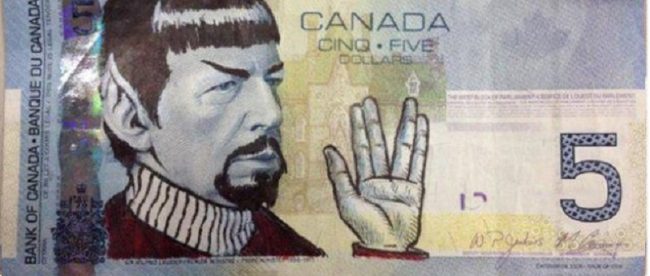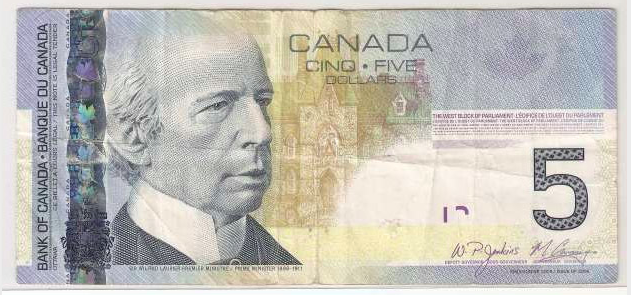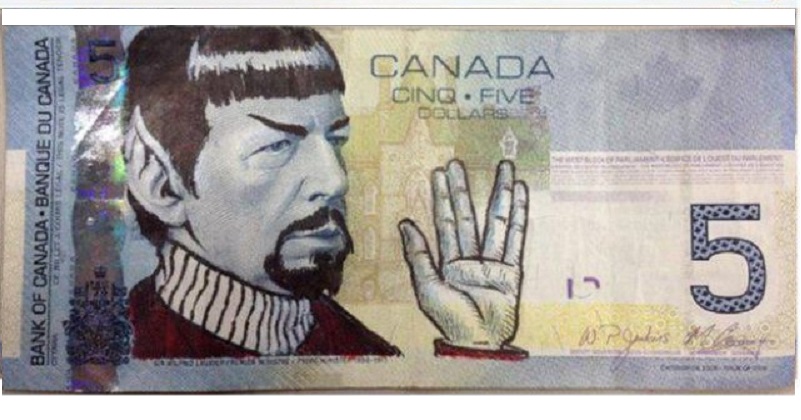What Canada Has In Common With Romulans


Sir Wilfrid Laurier served as Prime Minister of Canada from 1896 to 1911. His fifteen consecutive years in the office is still a record and helped establish Canada as an autonomous nation, one free of oversight from the British government. He’s often considered one of the nation’s top chief executives, and since 1972, his portrait has graced the $5 note, as seen above.
And, as depicted on the bill, he kind of looks like Spock.
You know, the Vulcan. From Star Trek. This guy.
A bit of a stretch? Maybe — but enough Canadians thought so to create a bit of a stir. Because they did something like this, redefining the term “vulcanization” in the process:

See? Spock.
Star Trek fans from the Great White North began on this enterprising art campaign as early as 2002. The as-printed $5 note “was an easy target,” as designed Todd Falkowsky told QZ; “the existing portraits are quite large and can be improvised with easily and the color of our $5’s are the same blue as Spock’s uniform” And when the actor who portrayed Spock, Leonard Nimoy, passed away in February of 2015, this was a small way for Canadian fans to pay tribute to the character he was best known for.
But not everyone was fond of the efforts to transform the Prime Minister into James T. Kirk’s emotionless first officer. Specifically, the trend spread so widely that the Bank of Canada felt compelled to comment — and to ask people to stop. Back in 2002, the Banke issued a statement, pleading for people to refrain from doing this, noting that “all writing on notes limits their life,” not allowing them to prosper in the stream of commerce. Continued the Bank, “Such instances of mutilation and defacement carry a cost associated with them due to accelerated requirements for note replacement. Further, the mutilation and defacement of notes is not condoned as Canadian currency is a symbol and source of national pride.” And when the fad re-emerged in 2015, the Bank renewed its objections.
These objections, though, did little to stem the tide. Why? Because in issuing these statements, the Bank also admitted that adding point ears and notable eyebrows (and a mirror-universe beard) to Laurier’s face wasn’t illegal — if you’re Canadian and have some Candian money on you, you’re free to draw on it as much or as little as you like. Doing so won’t earn you a punishment, and won’t even render the $5 note worthless. It will, however, make your money infinitely cooler looking.
And yet, “Spocking,” as the trend became known, has likely met its match. For reasons having nothing to do with Star Trek, Canada redesigned the bill in 2013, adding in a lot of anti-counterfeiting technology. In doing so, they also made Laurier look a lot less like everyone’s favorite Vulcan — they swapped out Laurier’s side-view portrait for a front-view one. The new ones are harder (but as seen here, not impossible) to transform.
Bonus fact: The main antagonist of the second Star Trek movie (“Star Trek II: The Wrath of Khan”) and an Original Series episode (“Space Seed”) is named Khan Noonien Singh. The character’s name was an effort by Trek-creator Gene Roddenbery to reconnect with Kim Noonien Wang, a friend during their mutual service in World War II. According to the Star Trek wiki Memory Alpha, “Roddenberry had lost touch with [Kim Noonien Wang] and hoped that his friend would see his name on television and contact him.” Unfortunately, there are no reports that the two ever reconnected.
From the Archives: How the Soviet Union Saved Vulcan: More Star Trek puns ahead.
